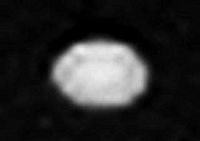Despina (moon) facts for kids
 Despina as seen by Voyager 2 (smeared horizontally) |
|
| Discovery | |
|---|---|
| Discovered by | Stephen P. Synnott |
| Discovered in | July 1989 |
| Orbital characteristics | |
|
|
|
| Semi-major axis | 52 526 ± 1 km |
| Eccentricity | 0.0002 ± 0.0002 |
| Orbital period | 0.33465551 ± 0.00000001 d |
| Inclination | 0.216 ± 0.014° (to Neptune equator) 0.06° (to local Laplace plane) |
| Is a moon of | Neptune |
| Physical characteristics | |
| Dimensions | 180×150×130 km |
| Mass | ~2.1×1018 kg (based on assumed density) |
| Mean density | ~1.2 g/cm3 (estimate) |
| Rotation period | assumed synchronous |
| Axial tilt | ~zero presumably |
| Albedo (geometric) | 0.09 |
| Surface temp. | ~51 K mean (estimate) |
| Atmosphere | none |
Despina, also called Neptune V, is one of the many moons orbiting the giant planet Neptune. It is the third closest moon to Neptune. This small, non-round moon was named after Despina, a nymph from ancient Greek stories who was a daughter of the sea god Poseidon.
Contents
How Despina Was Found
Despina was discovered in late July 1989. It was found by Stephen P. Synnott using pictures sent back by the Voyager 2 probe. This probe flew past Neptune and took many amazing photos. When it was first found, Despina was given a temporary name: S/1989 N 3. This is a common way to name newly discovered space objects before they get a proper name.
What is Despina Like?
Despina is not perfectly round like Earth's Moon. It has an irregular shape, measuring about 180 kilometers (112 miles) long, 150 km (93 miles) wide, and 130 km (81 miles) thick. Scientists believe it has not changed much since it formed. This means there are no signs of volcanoes or mountains forming on its surface.
Despina is a very dark moon. It reflects only about 9% of the sunlight that hits it. This is similar to the color of charcoal. The surface temperature is extremely cold, around -222 degrees Celsius (-368 degrees Fahrenheit). It does not have an atmosphere.
Despina's Orbit Around Neptune
Despina orbits very close to Neptune. It is inside Neptune's main ring system. It takes Despina only about one-third of an Earth day (about 8 hours) to complete one trip around Neptune. This is a very fast orbit!
Because it is so close, Despina is tidally locked to Neptune. This means the same side of Despina always faces Neptune, just like our Moon always shows the same face to Earth. Despina's orbit is almost a perfect circle and is very close to Neptune's equator.
Images for kids
See also
 In Spanish: Despina (satélite) para niños
In Spanish: Despina (satélite) para niños


